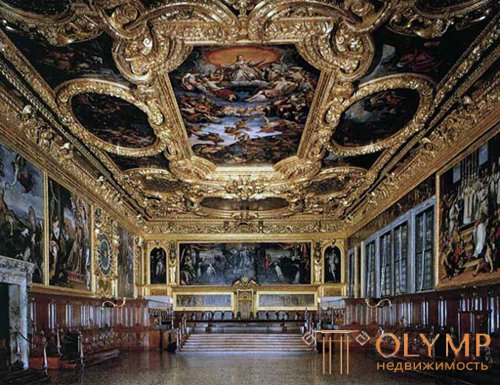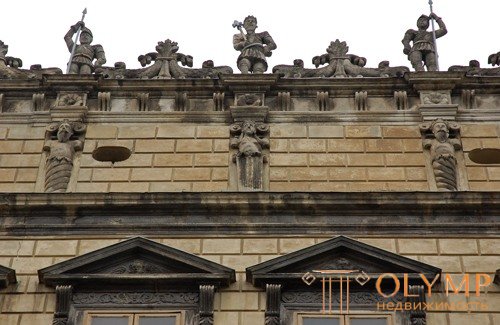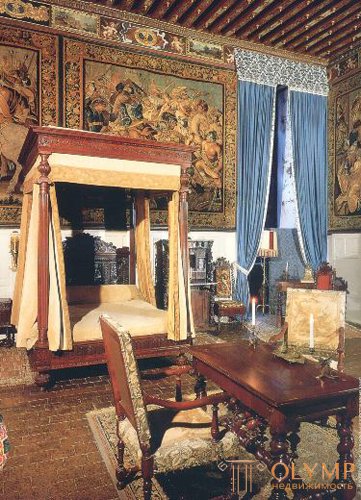
Mannerism ( Italian. Manierismo - pretentiousness, mannerism from maniera - method, method ) - the name conventionally denoting stylistic trends, as well as a certain stage in the development of European, mainly Italian, art of the middle and end of the XVI century (lasted about 25 years). The name "Mannerism" (from the word "manner") was given to contemporaries, who perceived it as a mannered - referring to the recent past, a repetition of his best achievements.
The art of Mannerism as a whole is characterized by the primacy of form over content. Exquisite technique, virtuosity of manner, demonstration of skill does not correspond to the paucity of design, secondary nature and imitation of ideas.
Mannerism is positioned as a transitional style from classical massive, monumental forms in the interior decoration of the Renaissance (Renaissance) to a new style that promotes pomp and grandeur, luxury and pathos - the Baroque style.
For Mannerism, the following are characteristic: elongation of figures, tension of poses (counterpost), unusual or bizarre effects associated with size, lighting or perspective, and bright colors.

Style Mannerism in the interior, photo
The main elements of the style of Mannerism:
Mannerism appeared in Italy, where Florence, Mantua and Rome became the most important centers of style development, and then it became widespread in France and other European countries. The style was partly generated by the crisis in the socio-political sphere, characteristic of the late Renaissance with its social, moral and religious instability; sometimes the initial phase of mannerism is associated with the plunder of Rome in 1527. Most importantly, mannerism in a catchy form reflected a significant, explosion-like transformation of art and literature from the Middle Ages to the New Age.
Mannerism began to call the style perceived by the schools of Italian art, primarily Roman, in the period between the High Renaissance and Baroque (about 1520 - about 1600).
This stage reflected the crisis of the artistic ideals of the Italian Renaissance. In the style of mannerism there is fatigue of style, the exhaustion of its vital sources. That is why this term is often interpreted more broadly, referring to Mannerism as the last, crisis phase of the development of any artistic style in various historical eras.
Mannerism became popular thanks to the artist and biographer of the 16th century Vasari, who characterized them with a high degree of grace, balance and sophistication in art.
However, since the 17th century, most critics, believing that the Italian art of the 2nd half of the 16th century experienced a decline compared with the peaks reached during the High Renaissance (Renaissance) Leonardo da Vinci, Michelangelo and Rafael, the term “Mannerism” was attributed to art, which peculiar to metaphorical saturation, addiction to hyperbole and grotesque.
For the first time after the Renaissance, the harmony of content and form, image and expression that had been achieved so hard began to disintegrate due to the overdevelopment and aesthetization of individual elements, graphic means: lines and silhouette, colorful spots and textures, strokes and strokes.
The beauty of a single detail became more important than the beauty of the whole. This path is inevitable for the evolution of the forms of any artistic style, but the greatest Renaissance in its artistic achievements was also created by outstanding Mannerism.
It is customary to talk about Mannerism since Raphael, when he abandoned the extremely clear and balanced means of expression characteristic of High Renaissance, and began to work in a more sophisticated manner.
Mannerism in architecture is also difficult to define, as in painting and sculpture, but often involves conscious contempt for the established rules and classical traditions. Mannerism in architecture expresses itself in violations of the Renaissance balance; the use of architectonically unmotivated, causing the viewer a sense of anxiety structural solutions, elements of the grotesque. In this case, the grotesque is not a bizarre, comical and terrible mixture and bringing to the limit the combination of real and fantastic, but following the patterns of wall paintings found during the excavations of ancient Rome (grotesques, that is, works of art found in the grottoes).

Style Mannerism in the interior, photo
The interior decoration is dominated by ornaments, saturated with grotesque, fancy, fantastic images. Throughout the world using art in the design, artists of this period constantly turn to allegorical images, symbolism and emblems, with the aim of creating images close to the spirit of secular society.

Style Mannerism in the interior, photo
Interiors in the style of mannerism are characterized by the absence of certain principles of form organization. Classical elements, illusive stunts (false doors, blind windows and arches) are used unconventionally in architecture.
In the manner of Mannerism, the facades are decorative, with many architectural, sculptural, ornamental details, the use of rich gold and silver inlays, distortion of proportions, mixing styles, exaggeration of accents, bright colors, in paintings and sculptural compositions, unusual, fragmentary and lighting effects, perspective is used image of people with elongated proportions.

Style Mannerism in the interior, photo
In the interiors in the style of mannerism, the first thing that attracts our attention is the use in the interior (secular, not temple) paintings. Moreover, not only paintings (frescoes) painted directly on the walls of the premises, but also ornaments. Moreover, the eccentric decorators in the ecstasy decorate the pseudo-playnin on the ceilings and walls, which are almost indistinguishable from the present, pseudo-bas-reliefs and even pseudo-statues. This was by no means dictated by the savings. For people who ordered the decoration of their palaces, it was worthless to buy a couple of other works of famous modern sculptors or stone carvers. It was just fashionable. For those times not for long, only some twenty five years. But over the years, many Roman palaces have acquired the look of expensive caskets, where almost everything was deceptive.

Style Mannerism in the interior, photo
Following the painted stucco walls of scribbled multicolored marble appeared. And on these walls, painted windows opened and no less false doors and curtains, so naturally executed, concealed that only by touching them, you understand: everything is deception.

Style Mannerism in the interior, photo
The interior of the venue filled with ornaments. And frankly drawn, and imitating carvings and moldings. Ornaments simply reign, as the expressiveness of the lines becomes almost an end in itself. The world falls into color spots, strokes and strokes, folding into new shapes. In the interior decoration with might and main play with perspective, invented by light sources and unexpected, not always real planes and volumes. The beauty and expressiveness of the details becomes more important than the unity of the whole.

Style Mannerism in the interior, photo
Thus, in order to perform an interior in the style of Mannerism:
Mannerism made the transition from massive and heavy forms in the interiors of the Renaissance to a new style, personifying all the chic, wealth and pomp of the royal court - Baroque.
Что бы оставить комментарий войдите
Комментарии (0)